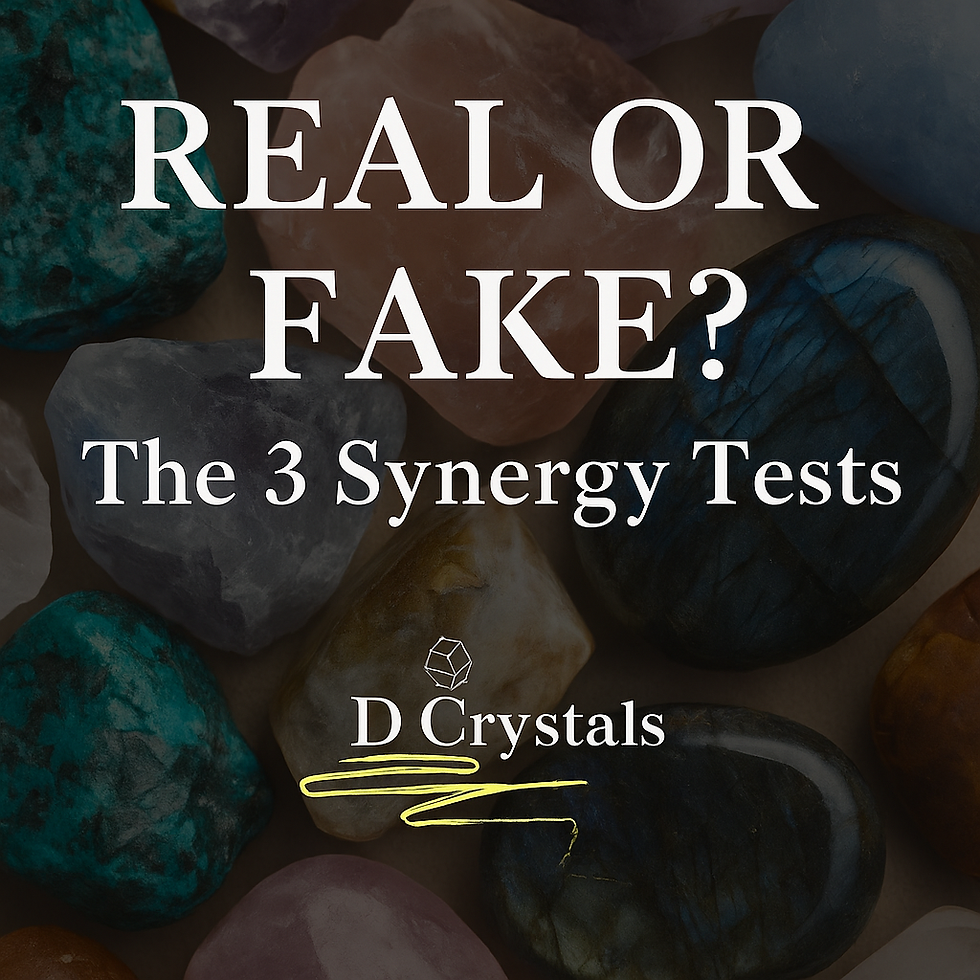Ever Wondered If Your Crystal is Fake ?
- D'Crystals
- Aug 12
- 2 min read
Crystals come in all colors and forms—but how can you truly tell them apart? Beyond visual inspection, gemologists and collectors use three reliable scientific methods: Mohs Hardness, Specific Gravity, and Refractive Index. Let’s break down how each method works—and explore a full table of popular crystals based on these characteristics.

Mohs Hardness Scale – How Tough Is Your Crystal?
The Mohs scale measures how resistant a crystal is to scratching, ranking minerals from 1 (very soft) to 10 (very hard). The higher the number, the harder the mineral.
Crystal | Mohs Hardness |
Diamond | 10 |
Topaz | 8 |
Quartz, Amethyst, Citrine | 7 |
Garnet | 6.5 – 7.5 |
Peridot | 6.5 – 7 |
Moonstone | 6 – 6.5 |
Amazonite | 6 – 6.5 |
Labradorite | 6 – 6.5 |
Rhodonite | 5.5 – 6.5 |
Turquoise | 5 – 6 |
Fluorite | 4 |
Amber | 2 – 2.5 |
Specific Gravity – Weight Without the Bulk
Specific Gravity (SG) is the ratio of a crystal's density compared to water. Denser stones feel heavier for their size.
Crystal | Specific Gravity |
Diamond | 3.52 |
Topaz | 3.49 – 3.57 |
Garnet | 3.5 – 4.3 |
Rhodonite | 3.4 – 3.7 |
Fluorite | 3.18 |
Peridot | 3.2 – 4.3 |
Labradorite | 2.68 – 2.72 |
Quartz (incl. Amethyst, Citrine) | 2.65 |
Sunstone | 2.62 – 2.65 |
Amazonite | 2.56 – 2.58 |
Moonstone | 2.56 – 2.60 |
Aquamarine | 2.68 – 2.74 |
Morganite | 2.71 – 2.90 |
Turquoise | 2.6 – 2.9 |
Amber | 1.05 – 1.10 |
Refractive Index – The Light Test
Refractive Index (RI) measures how much light bends as it passes through a crystal. Each crystal has a unique RI range.
Crystal | Refractive Index (RI) |
Diamond | 2.42 |
Zircon | 1.81 – 2.02 |
Garnet | 1.73 – 1.89 |
Rhodonite | 1.716 – 1.753 |
Topaz | 1.609 – 1.643 |
Peridot | 1.65 – 1.69 |
Aquamarine | 1.577 – 1.583 |
Quartz (incl. Amethyst, Citrine) | 1.544 – 1.553 |
Sunstone | 1.525 – 1.552 |
Amazonite | 1.522 – 1.530 |
Moonstone | 1.518 – 1.526 |
Labradorite | 1.559 – 1.573 |
Turquoise | 1.61 – 1.65 |
Fluorite | 1.433 – 1.436 |
Amber | 1.54 |
Why You Should Use All Three Together
Relying on just one test can be misleading. For example:
Quartz vs. Glass: Look similar, but quartz has a higher hardness and distinct RI.
Citrine vs. Topaz: Both yellow, but topaz is harder and denser.
Using Mohs + SG + RI gives you near-certain identification, especially when crystals are polished or tumbled.
Did You Know?
Colored glass often mimics crystals—but fails hardness and SG tests.
Fake turquoise usually has a much lower SG and inconsistent RI.
Diamond testers combine RI and conductivity for accuracy.
Explore Genuine Crystals at D Crystals
Every crystal at D Crystals is hand-picked, ethically sourced, and verified for authenticity. Whether you're building a collection or looking for healing properties, we ensure transparency in every piece. Shop with us to get natural crystals only.
References:
International Gem Society – Gem Identification
Geology.com – Gemstone Testing




Comments